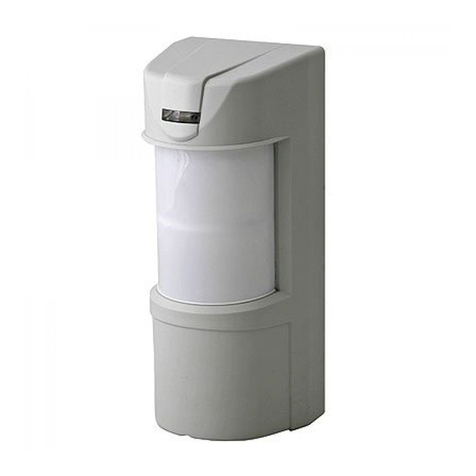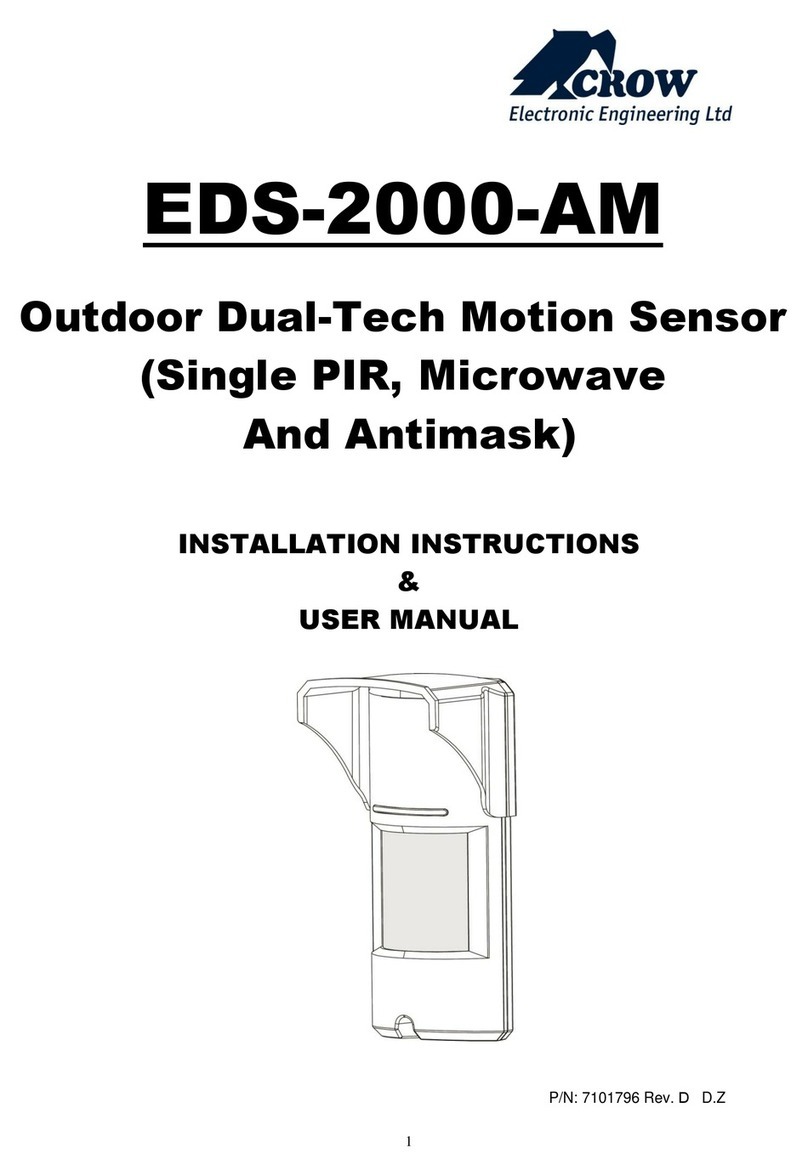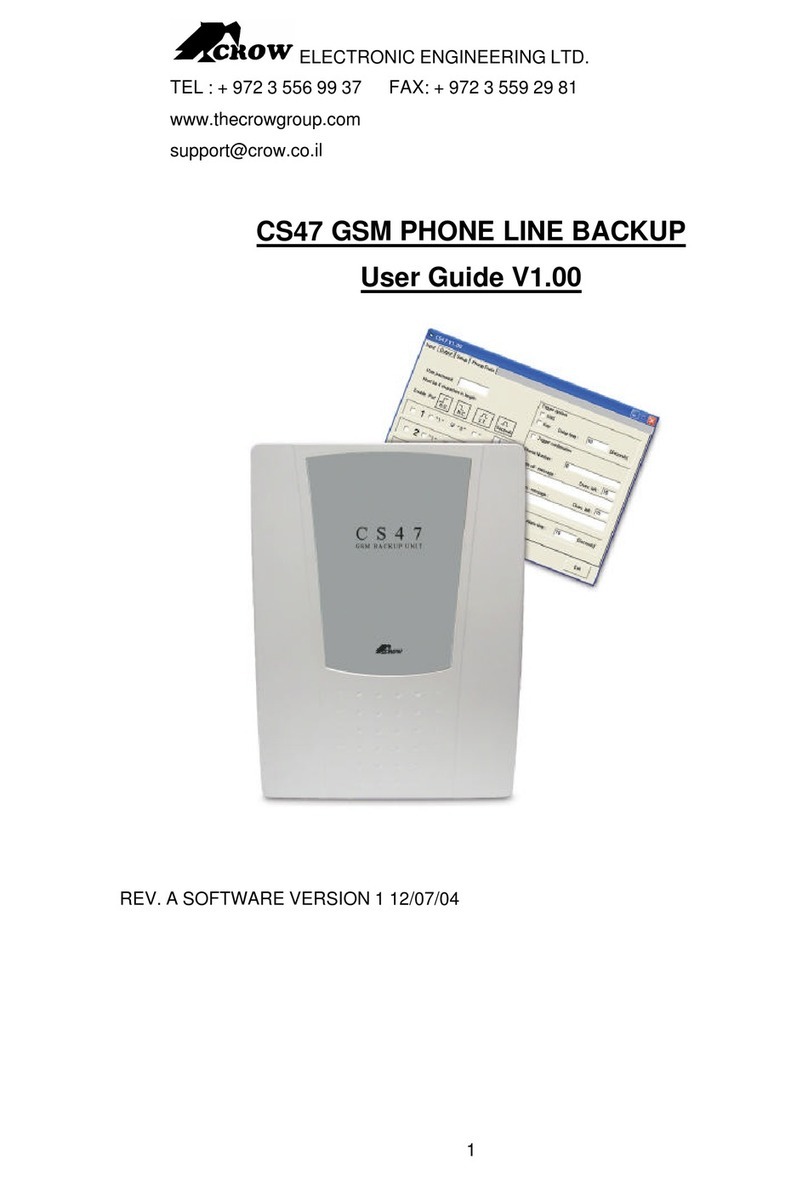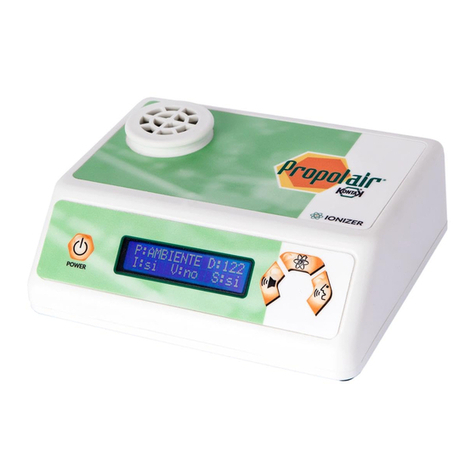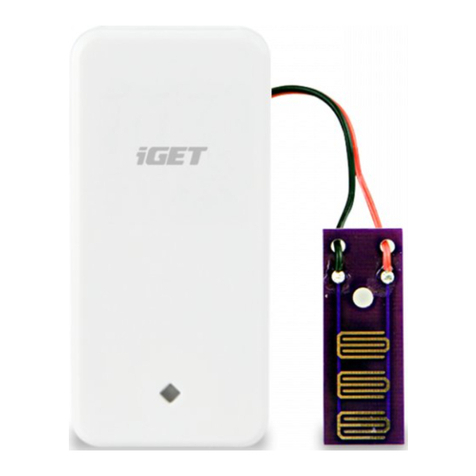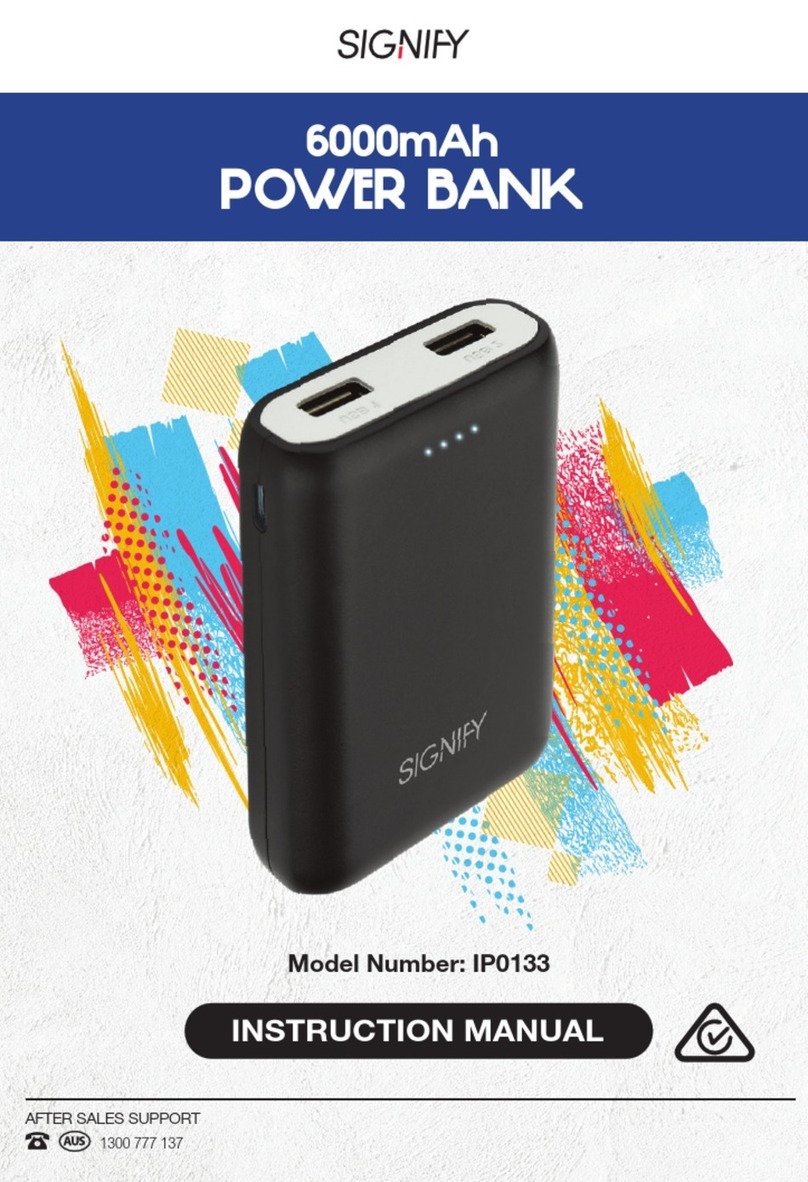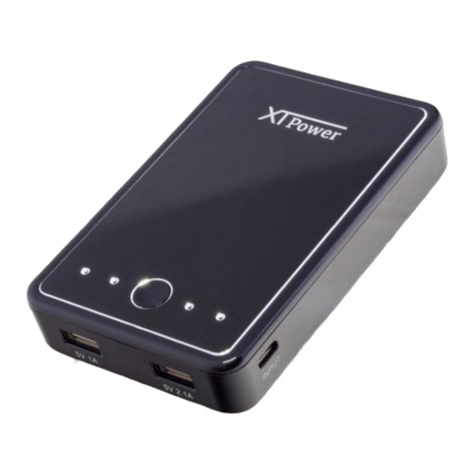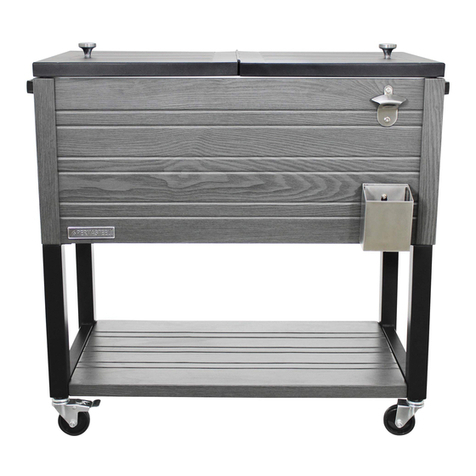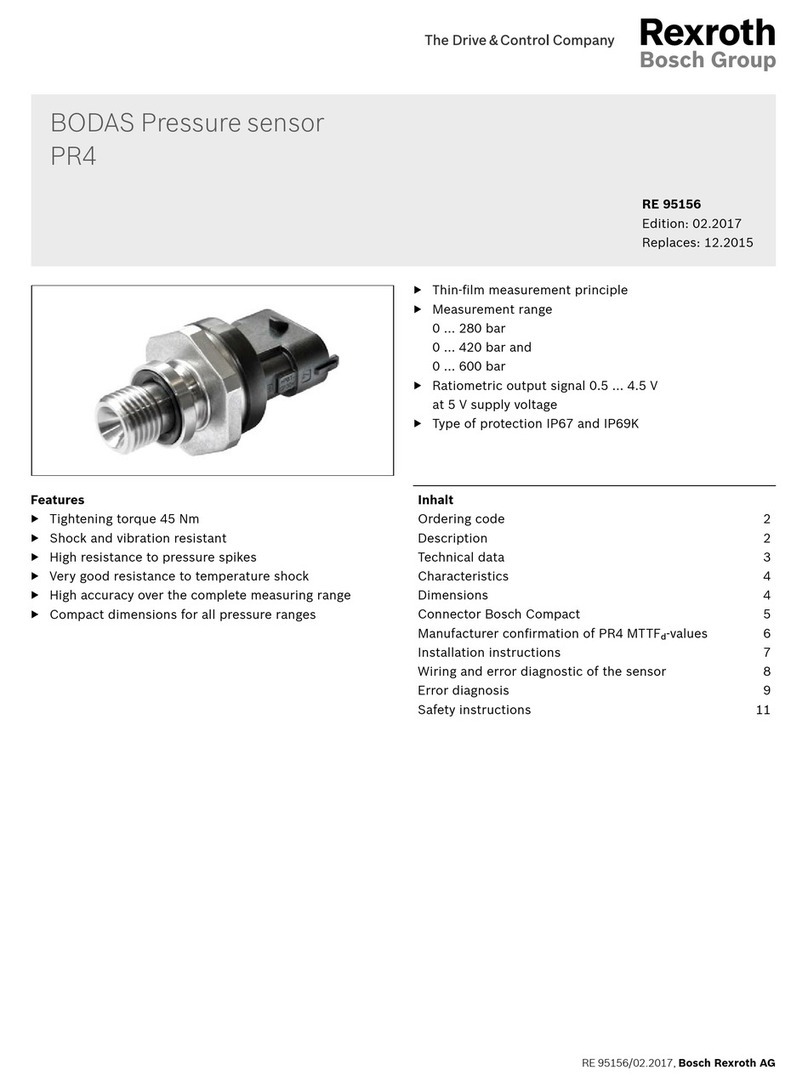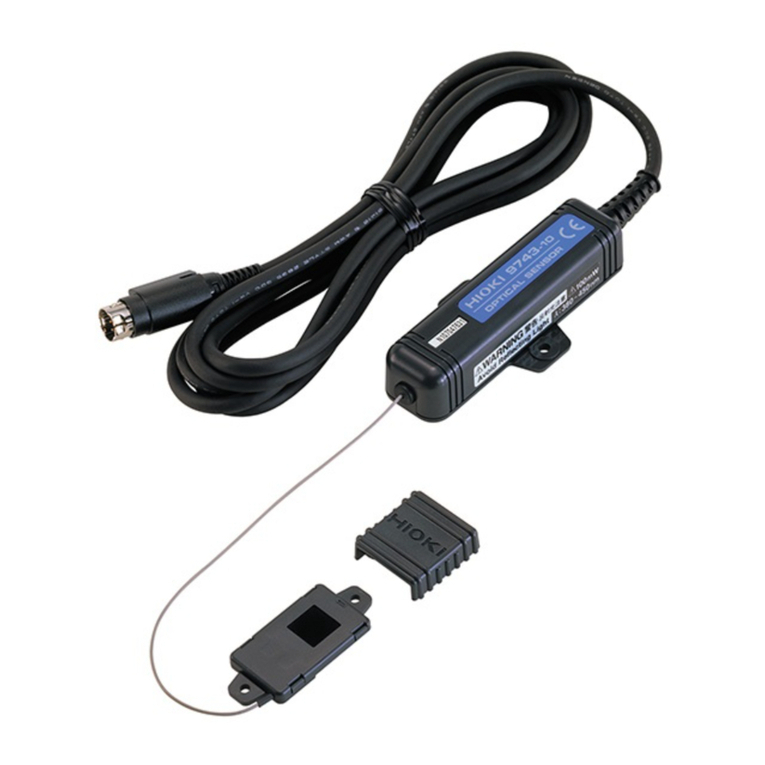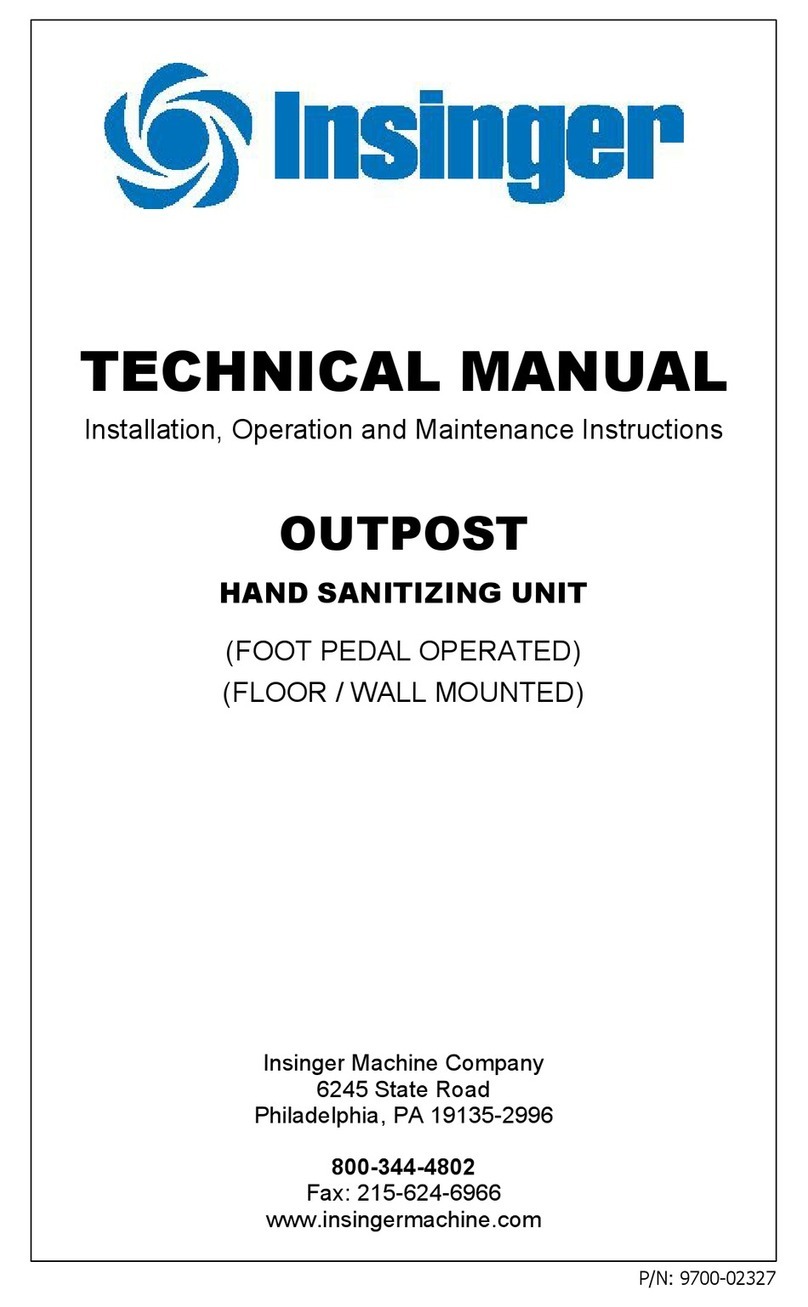Crow TALON SERIES Service manual

1
2
3
TALON SERIES
TLC-S
PROFESSIONAL
PASSIVE INFRARED &
MICROWAVE DETECTOR
ELECTRONIC ENGINEERING LTD.
INSTALLATION INSTRUCTIONS
P/N: 7151288 REV.B A.Y.
TLC-S FEATURES
A new generation of professional movement
spread spectrum analyzing PIR & MW
detectors.
Dual element PYRO sensor and hard lens for
outstanding detection performance and
elimination of false alarms.
Microwave detection based on Doppler concept.
Unique Microwave Motion Sensor Module with
microstrip patch antenna.
VLSI based electronics with movement speed
spectrum analysis.
AND & OR alarm signal selection.
Height installation calibrations free.
User-friendly installation with or w/o swivel
bracket.
2-way Microwave sensitivity adjustment.
2-way PIR sensitivity adjustment.
BI directional temperature compensation.
Environmental immunity.
The TLC-S is a combination of PIR & MW
detectors, providing protection from intruders by
PYRO sensor element and MW (based on Doppler
concept).
Using micro controller for PIR & MW signal
analyzing, with special ASIC technology for PIR
pulse processing, assure “false alarm free”
operation.
MOUNTING THE DETECTOR
Choose a location most likely to intercept an
intruder. (Our recommendation is a corner
installation). See detection pattern in Fig.: 5, 6.
The dual-element high quality sensor detects
motion crossing the beam; it is slightly less
sensitive detecting motion toward the detector.
The TLC-S performs best when provided with a
constant and stable environment.
NOTE
: recommended installation height is 2.4m
(option: 1.5m to 3.0m).
4
5
6
AVOID THE FOLLOWING LOCATIONS
Facing direct sunlight.
Facing areas subject to rapid quick
temperature changes.
Areas with air ducts or substantial air flows.
Facing metal doors.
WIRE SIZE REQUIREMENTS
Use the following table to determine required
wire gauge and length.
Wire Diameter mm .5 .75 1.0 1.5
Wire Gauge: # 22 20 18 16
Wire Length: m 205 310 510 870
Ft. 800 1200 2000 3400
FIG. 1 - REMOVAL OF FRONT COVER
1. To remove the front cover, insert a flat
screwdriver in the slot between the front and
the bottom above the holding screw hole and
push gently, until the front cover is
disengaged and the opening click is
heard.(Fig. 1)
2. Remove the PC board (unscrew holding
screw)
3. Break out the desired holes for proper wiring
as per fig. 2.
4. Insert the wire through the wire access hole,
and mount the detector base to the wall,
corner or ceiling with the necessary number
of screws and the suitable bracket.
5. Reinstall the PC board.
6. Access for wiring connections is easy via the
terminal block located on the PCB. See fig. 3.
7. Replace the cover by inserting it back in the
appropriate closing pin until the closing click
is heard.
7
8
9
FIG. 2 - KNOCKOUT HOLES
FIG. 3 -
TERMINAL BLOCK
CONNECTIONS
Terminal 1 – Marked “ - ” ( GND )
Connect to ground of the control unit.
Terminal 2 – Marked “ + ” ( +12V )
Connect to a positive Voltage output of 8.2 -16Vdc
source (usually from the alarm control unit)
Terminals 3 & 4 - Marked “ RELAY ”
These are the output relays contacts of the
detector. Connect to a normally closed zone in the
control unit.
Terminals 5 & 6 - Marked “ TAMPER ”
If a Tamper function is required connect these
Terminals to a 24-hour normally closed protective
zone in the control unit. If the front cover of the
detector is opened, an immediate alarm signal will
be sent to the control unit.
FIG. 4 - PCB LAYOUT
10
11
12
MW SENSITIVITY ADJUSTMENT
JUMPER “JP1”
-
provides sensitivity control of
MW (DOPPLER) according to the environment.
Position Up – “H” – High sensitivity
For normal operation – immediately detection.
Position Down – “L” – Low sensitivity
For harsh environments.
POTENTIOMETER “RV1” – adjusts the
detection pattern scale between 30% and
100% (factory set to 70%). Rotate the
potentiometer clockwise to increase pattern
scale.
Rotate the potentiometer counter-clockwise to
decrease pattern scale.
The potentiometer at min. “ – “ is equivalent to a
distance of 6m - 8m.
Dimension change according to installation
location and room size
PIR SENSITIVITY ADJUSTMENT
JUMPER “JP4” - provides sensitivity control of
PIR according to the environment.
Position Up – “H” – High sensitivity
For stable environments.
Position Down – “L” – Low sensitivity
For harsh environments.
POTENTIOMETER “RV2” – adjustment
according to protected area range.
Use RV2 to adjust the detection range between
68% and 100% (factory set to 84%). Rotate the
potentiometer clockwise to increase range,
counter-clockwise to decrease range.
ALARM MODE SETTING
JUMPER “JP2” OR - AND
Position Left “OR”
The alarm signal (relays activation) occurred
when one of the sensor’s signals - PIR OR MW -
is present.
The effective detection range is the range of the
PIR pattern OR MW pattern correspondently.
Position Right “AND”
The alarm signal occurred only when both
sensors (PIR AND MW) are present at the same
time.
The effective detection range is the range of which
the PIR patterns AND MW lobe are intersected.
You must reset the detector from
Control Panel before the new
settings will take effect.
A. Wire access
holes
B. Use for flat
wall mounting
C. Corner
mounting - use
all 4 holes.
Sharp left or
right angle
mounting - use
2 holes (top
and bottom)
D. For bracket
mounting
- + RELAY TAMPER
1 2 3 4 5 6
! "
# $
%&
!
'
!
$
! "
#
After adjusting the sensitivity perform a
walk test to verify optimum correct
sensitivity in the protected area.
2
N345

13
14
15
LED ENABLE/DISABLE SETTING -
JUMPER “JP3” (FIG.4)
Position Right “On” - LED ENABLE
The RED LED will activate when the SR-X
Is in alarm condition.
Position Left “Off” - LED DISABLE
The LEDS are disabled.
Note: the state of the Jumper “JP3” does not
affect the operation of the relay.
When an intrusion is detected, the LED will
activate and the alarm relay will switch into alarm
condition for 1.6 sec.
LED
INDICATORS (Fig.4)
YELLOW LED - MW detection’s
GREEN LED - PIR detection’s
RED LED - Alarm
TEST PROCEDURES.
Wait one-minute warm-up
time after applying
12 Vdc power. Conduct testing with the protected
area cleared of all people.
Walk test
1. Remove front cover.
Set LED to ON position.
2. Reassemble the front cover.
3. Start walking slowly across the detection zone.
4. Observe that the red LED lights whenever
motion is detected.
5. Allow 5 sec. between each test for the detector
to stabilize.
6. After the walk test is completed, you can set the
LED to OFF position.
NOTE:
Walk tests should be conducted, at least once a
year, to confirm proper operation and coverage of
the detector.
FIG. 5 - WA PIR + MW DETECTION
PATTERN
16
17
18
FIG. 6 - LONG RANGE CURTAIN LENS
PATTERN SCALE CALIBRATION
To calibrate the MW pattern scale, You need the
size of the room (length and detection angle).
For Doppler pattern see fig.7 and table1 on
Page 18, where H – Doppler pattern max;
## - zone number;
a – angle;
X,Y – appropriate coordinates of
Doppler pattern.
The potentiometer RV1(Fig. 4) adjusts according
to protected area range.
The potentiometer at mid-scale is equivalent to a
distance of 15m, at min-scale – 7m and
max-scale - is used with LR lens only.
FIG. 7 - MW PATTERN
Table 1:
## 0 1 2 3 4 5 6 7 8 9 10
a 180° 130° 100° 84° 75° 70° 60° 52° 40° 30° 20°
X 0 3 6 9 12 15 18 21 24 27 28,5
Y 10,5 6,09 7,15 6,98 8,01 10,5 10,39 10,24 8,73 7,23 5,03
X,Y are corresponds (m) of pattern points
when H=30m
19
20
21
LENSES-INTERCHANGEABLE HARD
TYPE LENSES PATTERNS
Standard Options
COVERAGE WIDE LONG RANGE
ANGLE CURTAIN
90.59
15m x 21m 21m x 3.5m
(50ft x 70ft) (70ft x 11ft)
TOTAL
ZONES 18 (36)* 5(10)
*7 (14) long range, 5 (10) intermediate,
6 (12) short range.
REPLACING THE LENS
1. Remove the front cover by inserting a flat
screwdriver in the appropriate slot (fig.1).
2. Using a small flat screwdriver, press on left,
right and middle snaps of the lens and pull the
lens out from its place (front cover side) (fig.8).
3. Replace a new WA or LR lens.
4. Push the lens to its place by pressing again
from outside of the front cover until a click is
heard (fig.8).
5. Replace front cover.
FIG. 8 - REPLACING THE LENS
TECHNICAL SPECIFICATIONS
Detection Method Dual element PIR & microwave pulse
Doppler
Maximumripple 2.4Vdc peak to peak at 12Vdc
Power Input 8.2 to 16 Vdc
Current Draw Active : 25.5 mA
Standby: 16.5 mA
Temperature
Compensation YES
Alarm Period 2 +/- 1 sec
Alarm Output N.C 28Vdc 0.1 A with 10 Ohm series
protection resistors
Tamper Switch N.C 28Vdc 0.1A with 10 Ohm series
protection resistor - open when cover
is removed
Warm Up Period 1 min
LED Indicator Yellow LED is blinking during warm up
period and self testing,
Red LED is ON during alarm
Red LED: UNIT ALARM
Green LED: PIR CHANNEL
Yellow LED: MW CHANNEL
22
23
24
TECHNICAL SPECIFICATIONS (CONT.)
Operating Temperature -20C to +50C(-4F to +122F)
RFI Protection30V/m 10 - 1000MHz
EMI Protection 50,000V of electrical
interference from lightning or power through
Visible Light Protection stable against halogen light 2.4 m
(8ft) or reflected light
MW output power min + 5 dBm IERP
Microwave frequency 2.45 GHz
MW harmonic emission -20dBm
Dimensions 137mm x 65mm x 49mm
(5.3” x 2.6” x 1.9”)
Weight 130 gr. (4.,6 oz)
CROW reserves the rights to change
specifications without prior notice
( & % & ) ( * & * + * & & * + % ) , - . - / * ) 0 ( % 0 & ) 1 ) &
2
!
!
" # $ % $ $
# & $ $
$ ' $
(
%
) * $ $
%
&
+ ,
$ $ $ ,
, ,
-
$ . $
$ .
% & . &
. % $
*
$ $ $ * $ $
/ 0
$
$ . $
,
# $ $ ,
0
%
$ $ $
#
0 $ # ,
CROW ELECTRONIC ENGINEERING LTD.
ISRAEL: 57 Hamelacha St., Holon 58855
Tel: 972-3-5569937 /8 /9
Fax: 972-3-5592981
USA: 2160 North Central Road,
Fort Lee, N.J. 07024
Tel: 1-800-GET CROW
or (201) 944 0005
Fax: (201) 944 1199
E-mail: support@crowelec.com
AUSTRALIA: 429 Nepean HWY Brighton East Vic 3187
Tel: 61-3-9596 7222
Fax: 61-3-9596 0888
E-mail: crow@crowaust.com.au
POLAND: VIDICON SP. ZO. O.
15 Povazkowska St.
01 – 797 Warsaw Poland
Tel: 48 22 562 3000
Fax: 48 22 562 3030
E-mail: vidicon@vidicon.pl
LATIN AMERICA: CROW LATIN AMERICA
5753 NW 151
ST
.Street
MIAMI LAKES,
FL 33014 – USA
Tel: +1-305-823-8700
Fax: +1-305-823-8711
E-mail: sales@crowlatinamerica.com
ITALY: DEATRONIC
VIA Giulianello 4/14
00178 ROMA, ITALY
Tel: +39-0676-12912
Fax: +39-0676-12601
E-mail: info@deatronic.com
7151288_B
90.5 °
30m
0m
5m
10m
15m
WA lens pattern 90.5 °(PIR)
MW pattern
5m
10m
15m
30m
18m
10m
5m
SIDE VIEW
TOP VIEW
H
0
2
1345678
9
10
Y
X
70’
21m
45’
13.6
12’
3.6
6’
2.4
8’
2.4
1.5’
0.4
0’
0
9º °
0’
0
SIDE VIEW
TOP VIEW
2
.
4m
This manual suits for next models
1
Other Crow Accessories manuals
Popular Accessories manuals by other brands

Fishman
Fishman PRO-EQ user guide
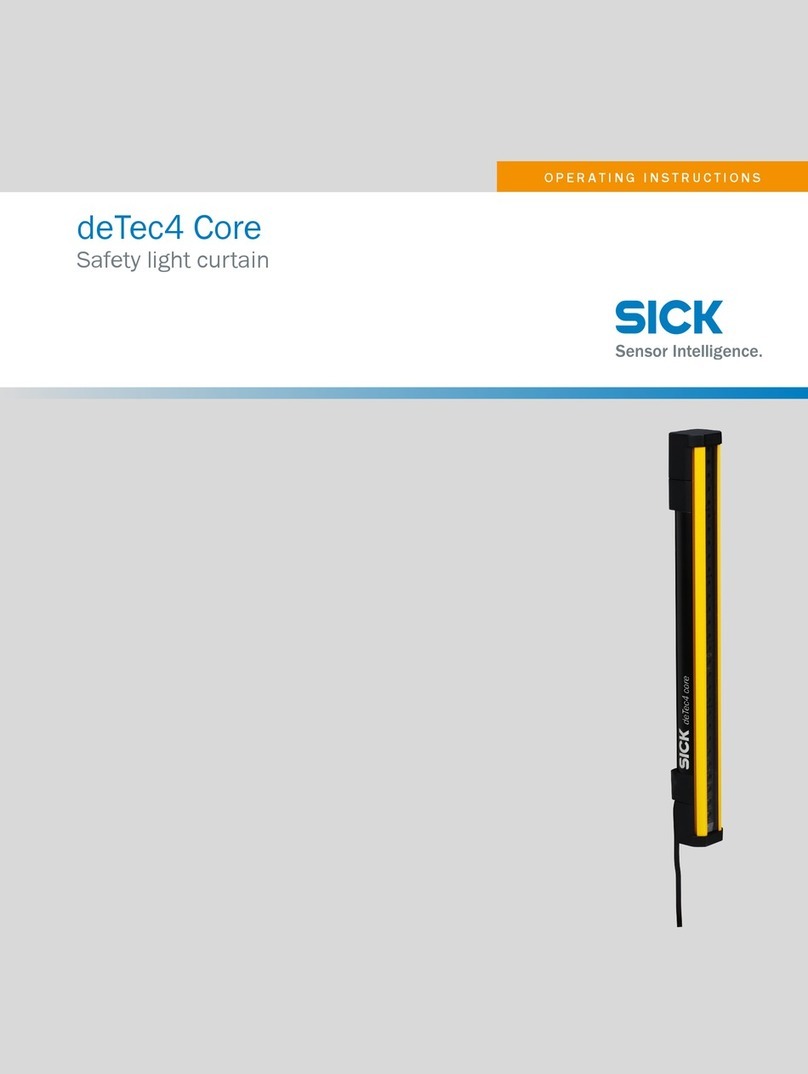
SICK
SICK deTec4 Core operating instructions

Niles
Niles WS120 installation guide
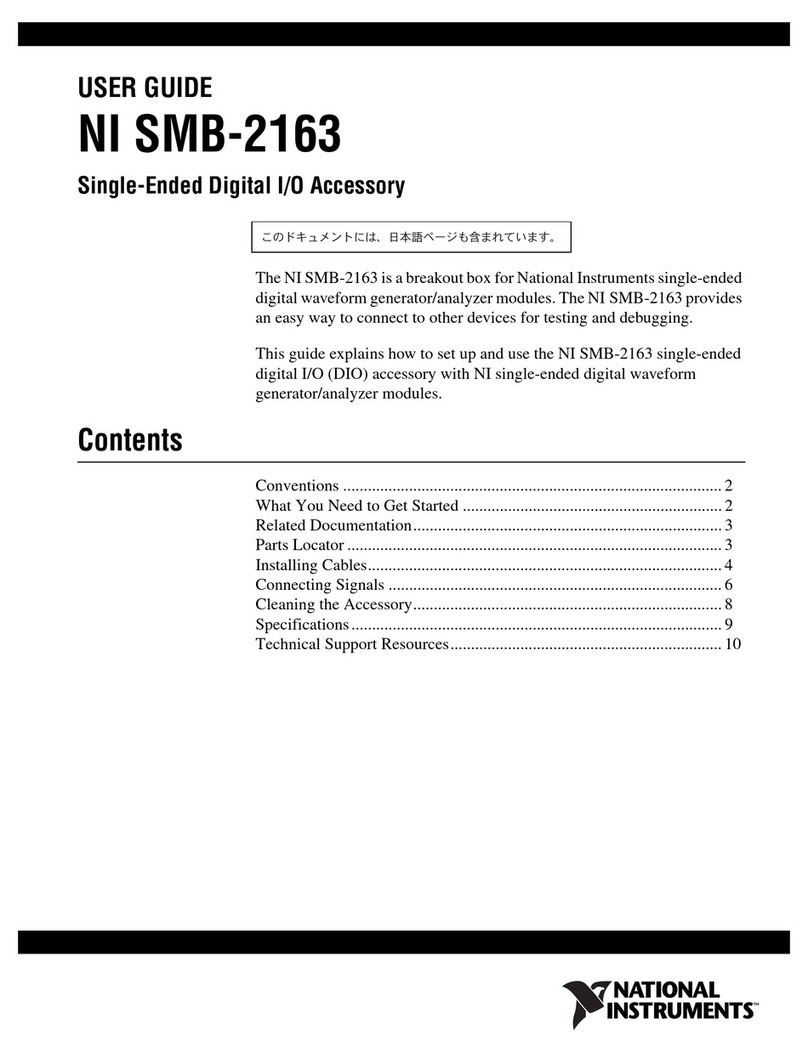
National Instruments
National Instruments Single-Ended Digital Waveform Generator/Analyzer Modules NI... user guide
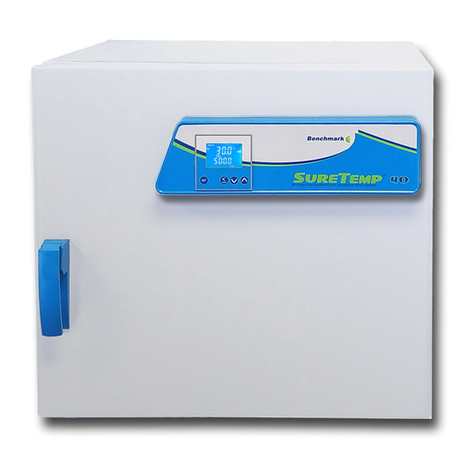
Benchmark
Benchmark SureTemp H2505-40 instruction manual
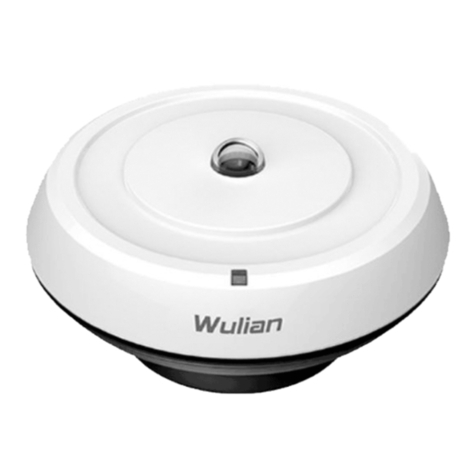
SmartRoom
SmartRoom SR-ZSSWBPW-AL-02 user manual
